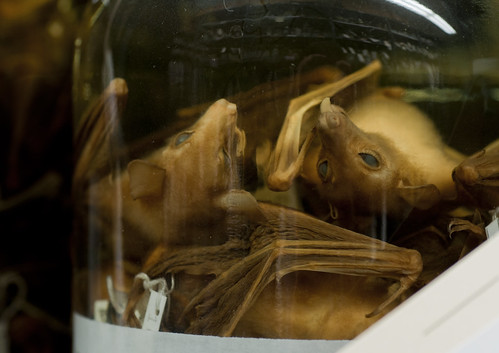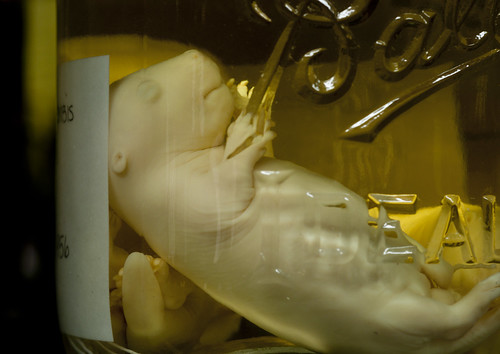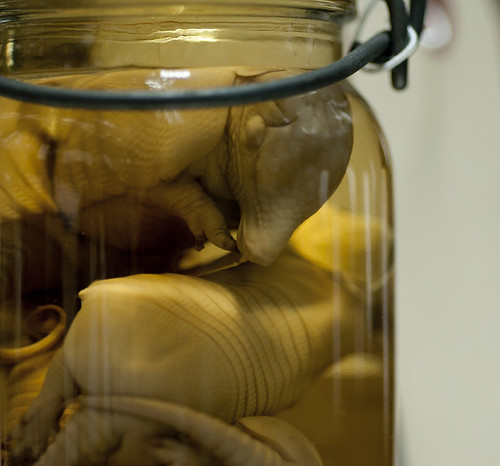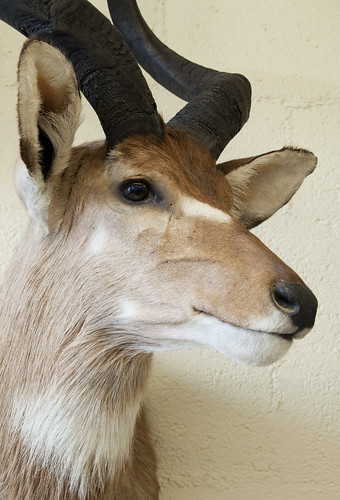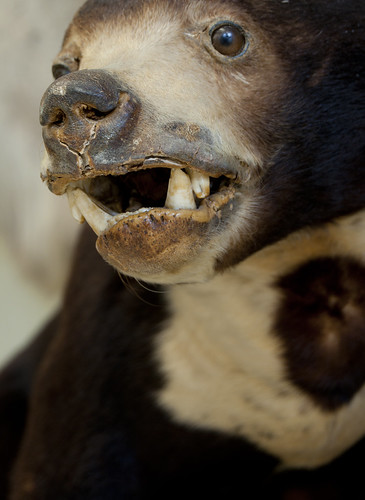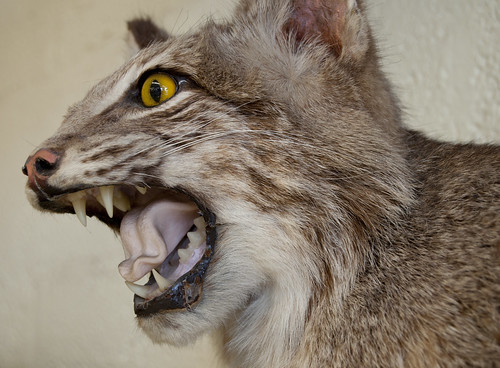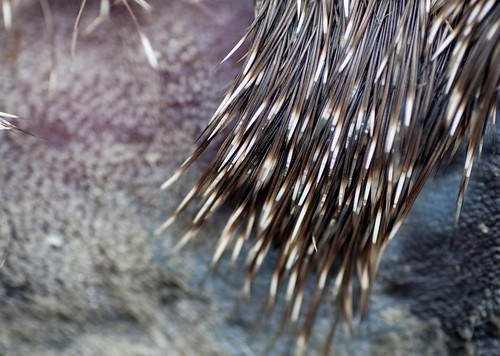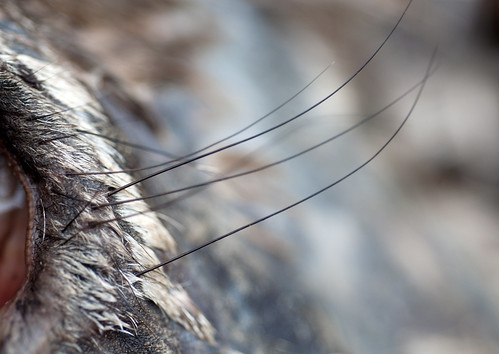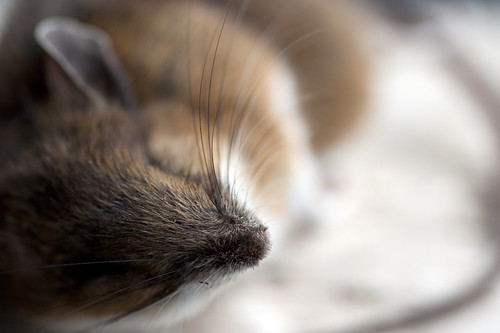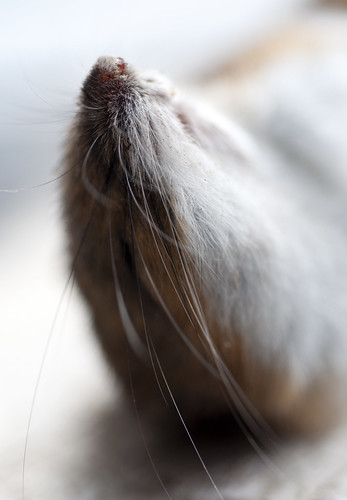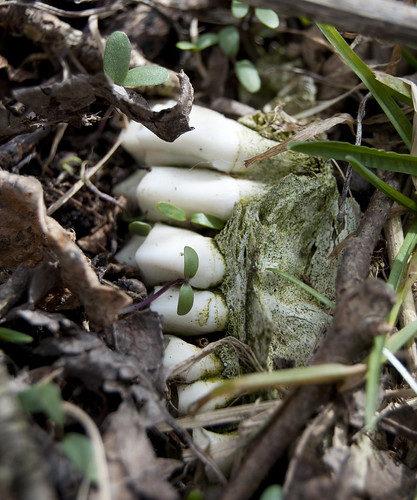When I think of suitable ways to preserve mammals, wet preservation (detailed here) isn't the first method that comes to mind. While alcohol and formalin are the preservatives of choice for invertebrates, fish, and herptiles, wet preservation does have its place in the mammal division, as well. For one, it's extremely useful for pickling small animals, such as bats and mice. When I visited the mammal division's fluids range last week, I marveled at just how many bats or mice could be crammed into a single Ball jar.
Another forte of wet preservation is its ability to preserve animal fetuses, which tend to be extremely fragile.
Tuesday, April 26, 2011
Sunday, April 24, 2011
Portraits
Recently, I took another trip to the mammal division at the University of Michigan's Museum of Zoology. The last time I visited, all of the donated African animal trophy mounts were resting on the tables, gazing skyward -- a bit of a bizarre sight. They have since been hung on the walls, giving the classroom the appearance of a trophy hunter's den. When they're hanging, the mounts seem even more impressive; the giant eland looked positively, well, giant. Now oriented correctly, the animals were less awkward and more regal, which provided for some interesting portrait opportunities.
Of the donated mounts, one of my favorites is the mule deer, one of the few, if any animals from the bunch that wasn't shot in Africa. The taxidermist who prepared the mount did a masterful job. The deer has such a well-crafted expression of both curiosity and seriousness, and it seems more natural and alive than any of the other mounts displayed.
Of the donated mounts, one of my favorites is the mule deer, one of the few, if any animals from the bunch that wasn't shot in Africa. The taxidermist who prepared the mount did a masterful job. The deer has such a well-crafted expression of both curiosity and seriousness, and it seems more natural and alive than any of the other mounts displayed.
Sunday, April 17, 2011
Burt Lake
Yesterday, surprising splashes of color were found along Burt Lake's stony shore...
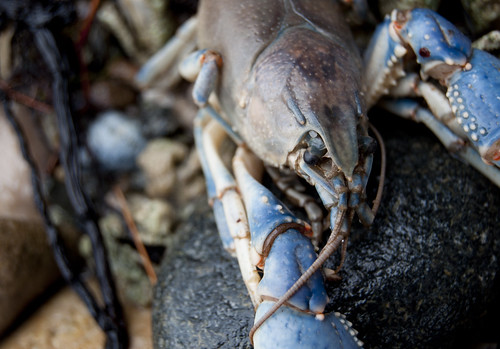
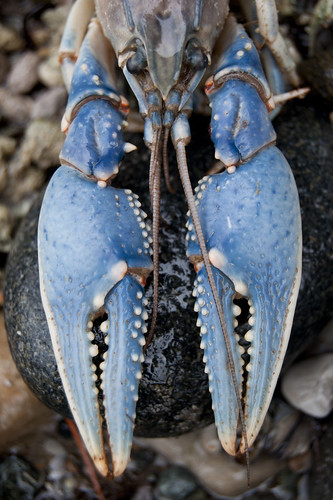
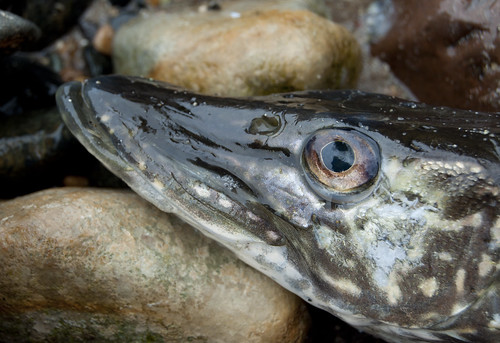


I'm not sure of this crayfish's species -- perhaps a virile crayfish (Orconectes virilis)? In any case, the animal had only recently died, and I was absolutely entranced by the vibrant blue of its pincers. The soft parts beneath the exoskeleton will likely be a tasty snack for a raccoon or gull.

Steph then found the very-fresh head of what we think is a northern pike. Pikes and muskellunges look awfully similar, but the coloration of this fish seemed to match with that of a pike. The mottled pattern was quite beautiful -- perfect underwater camouflage -- and its eyes were very striking. Looking inside the mouth, we discovered lots of tiny, sharp teeth. The rest of this pike's body was long gone, and soon, the head will be scavenged, as well.
Labels:
beach finds,
burt lake,
Cheboygan County,
crayfish,
Michigan,
pike
Sunday, April 10, 2011
Deer Decay
One month has passed since I found March Buck. When I first encountered the body, the front end, including the head, was rather intact, while the back half was in an advanced stage of decomposition. The hindquarters were stripped of meat, and the organs had been reduced to dirt; the rest of the body had a "fresh" appearance. Several scenarios can account for this condition, but the most plausible is as follows: shortly after death, the body was discovered by coyotes, who immediately ripped into the deer's hindquarters, as they tend to do. The corpse was subsequently buried by snow, and when it melted, decay continued. (I have since observed three different deer bodies on the Matthaei Botanical Gardens' property that have followed this same method of decomposition.)
My most recent visit to the remainder of March Buck, which was a week or so ago, revealed an articulated skeleton with a covering of skin. There really was no more meat left to speak of, and the only untouched parts of the body were the lower legs and feet.
The head of March Buck is, of course, undergoing a completely different process of decay. Though they have been observed in the area, coyotes can't get into my parents' backyard -- and something tells me they wouldn't be too interested, anyway. Crows have eyed the head, as has a turkey vulture; meanwhile, temperatures have been a little too chilly for the insects to really start picking away at the flesh. It has been rainy, though, and bacteria have been at work. Hair is falling from the skin, and the flesh, exposed, has transitioned through several colors: blood-red, purple, blue, gray.
My most recent visit to the remainder of March Buck, which was a week or so ago, revealed an articulated skeleton with a covering of skin. There really was no more meat left to speak of, and the only untouched parts of the body were the lower legs and feet.
The head of March Buck is, of course, undergoing a completely different process of decay. Though they have been observed in the area, coyotes can't get into my parents' backyard -- and something tells me they wouldn't be too interested, anyway. Crows have eyed the head, as has a turkey vulture; meanwhile, temperatures have been a little too chilly for the insects to really start picking away at the flesh. It has been rainy, though, and bacteria have been at work. Hair is falling from the skin, and the flesh, exposed, has transitioned through several colors: blood-red, purple, blue, gray.
At first glance, with its missing hair and blotchy, discolored flesh, the head is an ugly, putrid sight, but through a macro lens, beautiful details are revealed.
Labels:
Ann Arbor,
antlers,
deer,
march buck,
Michigan,
Saline,
Washtenaw County
Friday, April 8, 2011
Links to Enjoy!
Over the past several months, I've amassed a small number of bookmarks relating to dead creatures -- artwork, blogs, news, and so on. I thought it would be nice to share -- some of these links might be familiar, and others might be new... so enjoy!
Dead animals aren't the most common theme in art, but they've certainly become more popular in recent years, especially in the world of photography. The ever-amazing Chris Jordan, whose photography constantly leaves me in awe, made a series of photographs portraying the dead albatross chicks of the Midway Atoll. The photographs are both saddening and enraging, and are perhaps environmental activism art at its finest.
Birds seem to be the most frequent subject, as indicated by this series and this series, as well. I especially like the work of Thomas Brennan (second link): it's a very different look at museum study mounts and taxidermy, with the focus on form (or outline), instead of the flashy colors that birds tend to display.
Jake's Bones is a great blog run by a nine year-old boy in Scotland. He's got a knack for finding some pretty cool animal remains, and his thoughts and evaluations of each bone in his collection are educated, scientific, and fun to read.
Here is an interesting blog post about taxidermy, and it raises some interesting points as well as questions.
Lastly, here is an older article from the New York Times about counting and mapping roadkill.
I'm always on the lookout for new artists, interesting news articles, and blogs that are related to the world of dead animals and/or taxidermy. If you've got anything to share, please do!
Dead animals aren't the most common theme in art, but they've certainly become more popular in recent years, especially in the world of photography. The ever-amazing Chris Jordan, whose photography constantly leaves me in awe, made a series of photographs portraying the dead albatross chicks of the Midway Atoll. The photographs are both saddening and enraging, and are perhaps environmental activism art at its finest.
Birds seem to be the most frequent subject, as indicated by this series and this series, as well. I especially like the work of Thomas Brennan (second link): it's a very different look at museum study mounts and taxidermy, with the focus on form (or outline), instead of the flashy colors that birds tend to display.
Jake's Bones is a great blog run by a nine year-old boy in Scotland. He's got a knack for finding some pretty cool animal remains, and his thoughts and evaluations of each bone in his collection are educated, scientific, and fun to read.
Here is an interesting blog post about taxidermy, and it raises some interesting points as well as questions.
Lastly, here is an older article from the New York Times about counting and mapping roadkill.
I'm always on the lookout for new artists, interesting news articles, and blogs that are related to the world of dead animals and/or taxidermy. If you've got anything to share, please do!
Monday, April 4, 2011
Whiskers
Several days ago, my mother found a dead mouse at her workplace; it had fallen into an empty bucket and, unable to escape, eventually perished. It's not a very pleasant way to die, and this sort of death seems to be a frequent fate for mice. I have tentatively identified the rodent as a deer mouse; deer mice and white-footed mice are very similar in appearance.


This is the first intact mouse I've photographed, as the other two were both partially-eaten, most likely by cats. These macro photographs highlight just how long and delicate this animal's numerous whiskers are -- something I'd never really noticed before.
See also -- Rainy, March 5 2011 and A Feline "Gift", November 9 2010.
See also -- Rainy, March 5 2011 and A Feline "Gift", November 9 2010.
Labels:
Ann Arbor,
deer mouse,
Michigan,
rodents,
Washtenaw County
Saturday, April 2, 2011
Old Bones
On a recent off-trail tromp through the Matthaei Botanical Gardens' property, Steph and I made a beautiful discovery: the bones of a long-dead deer, scattered and covered by healthy, green turf. Parts of the skeleton were peeking through the growth: here a rib, there a jaw, just barely visible beneath the living, thriving grass. New plants sprouted up around a fragment of the skull, tiny cotyledons catching the sun next to very-white teeth. I feel very fortunate to have seen these bones; by summer they will be covered by vegetation, overgrown and hidden, perhaps for good.
Labels:
Ann Arbor,
bones,
deer,
matthaei botanical gardens,
Michigan,
usefulness,
Washtenaw County
Subscribe to:
Posts (Atom)

